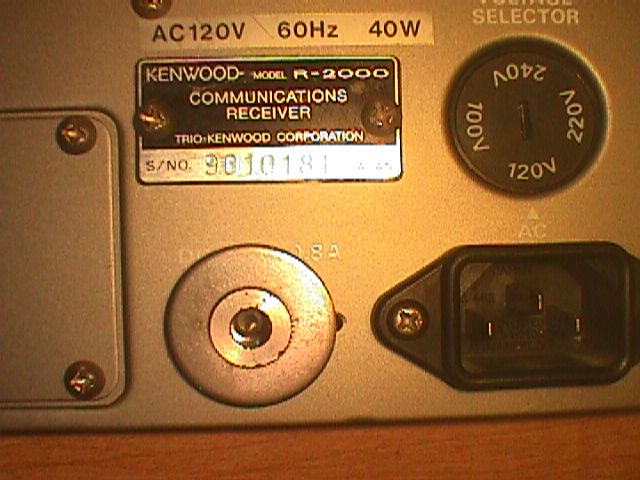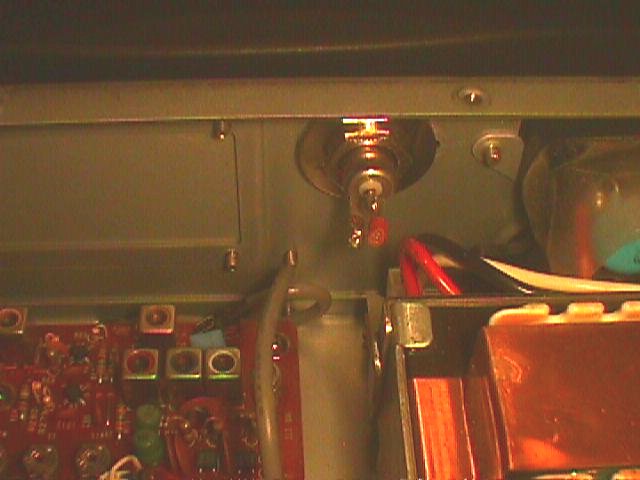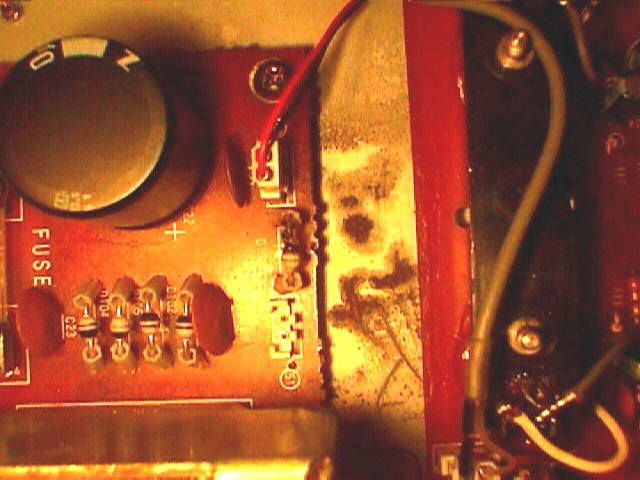R-2000
DC Power Mod
Submitted by Terry
I like to run my radio gear
from an external 12V power supply that has a Gel Cell for standby
power.
I use a Lambda power supply adjusted to provide 13.66V, which is the
"float"
voltage suggested by several Gel Cell manufacturers.
Kenwood makes an "adapter"
that consists of an external power connector and the internal connector
to plug into connector 51 on the DC power board. I choose to
"roll
my own".
Because I have been working
on my R2000 for about a month, and because I wanted to eliminate or
reduce
sources of trouble I removed the added internal power supply parts and
will re-install them in the near future. At the present time my
R2000
is being powered by the normal AC Mains connector. This does make
the R2000 run much warmer then when powered from DC.
I purchased an 5.5mmOD/2.1mmID
coaxial connector from Radio Shack, and a couple of thin washers from
the
local hardware store. I removed the cover, held on by 2 small
Phillips
screws, and installed the connector and washers. I did not have
the
proper connector to mate with connector #51, so I soldered a thin wire
to the anode of D1.
I placed a ferrite torroid
choke in series with an 1.5A micro fuse.
I ran a piece of ground
wire from the negative terminal on the coaxial connector to a ground
lug
that I placed under one of the mounting screws of the DC power
board.
I also connected a 15V Zener diode from the anode of D1 to this ground
lug. This provided both protection from external over voltage and
protection from a reversed DC connection. I also placed a bypass
capacitor across the positive and negative terminals on the coaxial
power
connector. The total cost was less then $10 (USA) because I had
the
Zener in my junk box.
My R2000 internal DC power
supply produces 14.75V DC when operated from AC. The slight
difference
in voltage from the AC or my external DC has no real effect on the
operation
of the R2000. The display is slightly dimmer and the overall gain
of the radio is slightly lower when powered from the external supply
versus
the internal AC derived supply. But the R2000 has enough gain so
the minor decrease is not an issue. There were no noticeable
differences
in overall sensitivity or in the stations received. My R2000 runs
much cooler when operated from external DC because the internal AC
power
transformer is the main source of heat.
This is a very simple, yet
useful modification. It allowed me to take my R2000 out into the
woods with a small gel cell and get hours of listening. I also
made
a set of cables to allow the R2000 to be connected to a car
battery.
My wife likes the ability to listen to the R2000 while on
picnics.
I made the modification to the R2000 within the first month that I had
it. I recently changed the DC power coaxial connector to theRadio
Shack one because the one I had was rather flimsy and the bronze
contact
for the outer sleeve had become intermittent.
As always the standard disclaimer
applies:
* Proceed at your own
risk.
* It is your radio and
your responsibility to determine if you have the skills to do this
modification
and to operate it in a safe manner from an external DC power source.
* DO NOT leave out the
fuse or the protective Zener diode or you will FRY your R2000!
There are three photographs
that show points of interest for the DC power hookup.
The first one above was an
outside view of the coaxial power connector showing the Radio Shack
connector,
and the washers I used to fill in the stock mounting hole.
The second one below here
is the inside view of this same connector. Again, notice how I
used
washers to fill in the stock mounting hole:

The final one below here
shows the point where I feed the external power. I chose to
bypass
the stock entry point because it has an Si diode to prevent reverse
power
application, but that diode steals 0.7V and because I am already
operating
at less than the voltage produced by the AC Mains power supply, I could
not afford the extra loss.  The Zener will limit reverse voltage to about 0.7V and the fuse blows
so
fast that no damage should occur. I have used this technique on
many
devices and, while I have blown more than my share of fuses, I have
never
had any equipment suffer damage. Again it is your radio, so take
the steps that you feel are acceptable.
The Zener will limit reverse voltage to about 0.7V and the fuse blows
so
fast that no damage should occur. I have used this technique on
many
devices and, while I have blown more than my share of fuses, I have
never
had any equipment suffer damage. Again it is your radio, so take
the steps that you feel are acceptable.
(The CW Narrow Collins Mechanical
filter can also be seen. This is one modification that I would
not
do today, because at 170Hz the bandwidth is just too narrow to be
useful.)
One minor point, because
I thought I might not be able to repair my R2000, I bought a DX-398 and
will be taking it on picnics from now on. At 14+ years, I suspect
my R2000 will last much longer if it is not bounced around on trips
into
the woods. The DX-398 is a very good receiver, not quite as good
as the R2000, but at the closeout price of $100, it was a great bargain.
I will restore the "standard"
power connection to my R2000 in the near future.
Suggestions,
comments,
corrections or additions may be emailed here.
RETURN
TO THE MODS PAGE
or
RETURN
TO THE DIRECTORY


 The Zener will limit reverse voltage to about 0.7V and the fuse blows
so
fast that no damage should occur. I have used this technique on
many
devices and, while I have blown more than my share of fuses, I have
never
had any equipment suffer damage. Again it is your radio, so take
the steps that you feel are acceptable.
The Zener will limit reverse voltage to about 0.7V and the fuse blows
so
fast that no damage should occur. I have used this technique on
many
devices and, while I have blown more than my share of fuses, I have
never
had any equipment suffer damage. Again it is your radio, so take
the steps that you feel are acceptable.